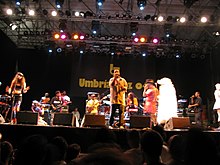
Back Groove Catalan Groove CRH Groove Czech Groove (Musik) German Ritmomodelo Esperanto Groove (música) Spanish Groove Finnish Groove French גרוב HE Groove Italian

In music, groove is the sense of an effect ("feel") of changing pattern in a propulsive rhythm or sense of "swing". In jazz, it can be felt as a quality of persistently repeated rhythmic units, created by the interaction of the music played by a band's rhythm section (e.g. drums, electric bass or double bass, guitar, and keyboards). Groove is a significant feature of popular music, and can be found in many genres, including salsa, rock, soul, funk, and fusion.

From a broader ethnomusicological perspective, groove has been described as "an unspecifiable but ordered sense of something that is sustained in a distinctive, regular and attractive way, working to draw the listener in."[2] Musicologists and other scholars have analyzed the concept of "groove" since around the 1990s. They have argued that a "groove" is an "understanding of rhythmic patterning" or "feel" and "an intuitive sense" of "a cycle in motion" that emerges from "carefully aligned concurrent rhythmic patterns" that stimulates dancing or foot-tapping on the part of listeners. The concept can be linked to the sorts of ostinatos that generally accompany fusions and dance musics of African derivation (e.g. African-American, Afro-Cuban, Afro-Brazilian, etc.).[2]
The term is often applied to musical performances that make one want to move or dance, and enjoyably "groove" (a word that also has sexual connotations).[2] The expression "in the groove" (as in the jazz standard) was widely used from around 1936 to 1945, at the height of the swing era, to describe top-notch jazz performances. In the 1940s and 1950s, groove commonly came to denote musical "routine, preference, style, [or] source of pleasure."[2]
- ^ Peckman, Jonathan (2007). Picture Yourself Drumming, p. 50. ISBN 1-59863-330-9.
- ^ a b c d Kernfeld, Barry. "Groove (i)". The New Grove Dictionary of Jazz, 2nd ed. (Grove Music Online). Oxford Music Online. Retrieved 16 October 2015.
In the realm of jazz, a persistently repeated pattern. More broadly, Feld (1988), studying groove from an ethnomusicological perspective, defines it cautiously as "an unspecifiable but ordered sense of something that is sustained in a distinctive, regular and attractive way, working to draw the listener in." Connections to dance are important, and the statement that a performance has, or achieves, a groove, usually means that it somehow compels the body to move. Still more generally, the term has a sexual origin and connotation which is obvious, requiring no explanation... Within jazz circles, Gold identifies the phrase "in the groove" – which from around 1936 to 1945 (i.e., during the height of the swing era) was in widespread use in referring to jazz performances which were "excellent" or, by extension, "sophisticated" – and the term "groove" – referring in the 1940s and 1950s to "routine, preference, style, source of pleasure"... Characteristically... [groove] tends to operate with reference to styles from the latter third of the twentieth century which utilize characteristic accompanimental ostinatos drawn from African-derived dance music, whether African-American (e.g., soul, funk, disco, rap, hip-hop), Afro-Cuban dance music (e.g., salsa), or Afro-Brazilian (samba), or some other such fusion.
(subscription required)
© MMXXIII Rich X Search. We shall prevail. All rights reserved. Rich X Search